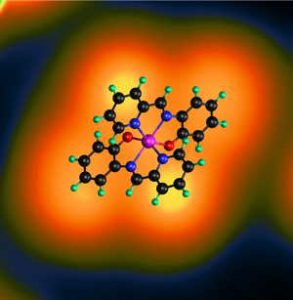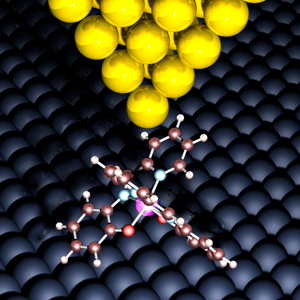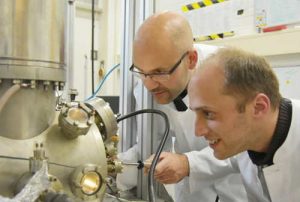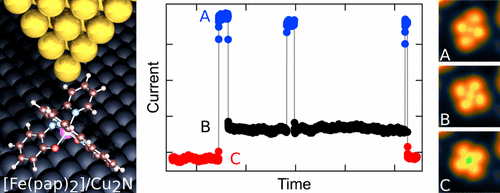R&D: Towards Storage at Single Molecule Level From Kiel University
Proof of concept, reversible and selective nature of switching used to build two-molecule memory
This is a Press Release edited by StorageNewsletter.com on December 14, 2017 at 2:24 pmFrom Kiel University – Christian-Albrechts-Universität
Research team at Kiel University saves information on a single molecule.
Images from the scanning tunnelling microscope (STM)
show the three different states of the molecule, which correspond
to a trinary code for encrypting information:
in a highly magnetic state (left), in a low magnetic state
with atoms that have moved closer together (middle)
and in an equally low magnetic state but turned by 45° (right).
Figure/copyright: Manuel Gruber
Over the past few years, the building blocks of storage media have gotten ever smaller. But further miniaturization of the current technology is hindered by fundamental limits of quantum mechanics.
A new approach consists in using so-called spin-crossover molecules as the smallest possible storage unit. Similar to normal hard drives, these special molecules can save information via their magnetic state. To do so, they have to be placed on surfaces, which is challenging without damaging their ability to save the information. A research team from Kiel University has now not only managed to successfully place a new class of spin-crossover molecules onto a surface, but they have also used interactions which were previously regarded as obstructive to improve the molecule’s storage capacity. The storage density of conventional hard drives could therefore theoretically be increased by more than one hundred fold, and data carriers could be made significantly smaller. The scientists have published their findings in the scientific journal Nano Letters.
Fe(III) spin crossover molecule used in the experiment
under the STM, with a model of its structure placed on top.
Figure/copyright: Manuel Gruber

Is a switch on or off? Is a statement true or false? Is an answer yes or no? The differentiation between two possibilities is the smallest piece of information that a computer can save. Bits (a word comprised of ‘binary’ and ‘digit’), as the smallest electronic storage unit, are the basic building blocks for all information stored on our hard drives. They are presented as a sequence of two different symbols like 0 and 1, the so-called binary code. Over the past few years, storage media have become ever smaller while their capacity to store information has increased. One bit on a hard drive now only requires a space of around 10 by 10 nanometres. This is still too big for miniaturising components, however.
Tip of the STM (yellow) assumes the role of a hard drive’s
reading and writing head for the molecule attached
to the copper nitride surface (black).
Figure/copyright: Manuel Gruber
“The technology that is currently being used to store data on hard drives now reaches the fundamental limits of quantum mechanics due to the size of the bit. It cannot get any smaller, from today’s perspective,” says Torben Jasper-Tönnies, doctoral researcher, Pr. Richard Berndt’s working group, Institute of Experimental and Applied Physics, Kiel University.
Dr Manuel Gruber (left) and Torben Jasper-Tönnies
from the Institute of Experimental and Applied Physics
use an STM to switch and read a magnetic molecule
on a copper nitride surface.
Photo/copyright: Julia Siekmann, Kiel University
Click to enlarge
He and his colleagues used a single molecule, which could be employed to encode a bit, to demonstrate a principle which might just enable even smaller hard drives with more storage in the future.
“Our molecule is just one square nanometre in size. Even with this alone, a bit could be encoded in an area hundred times smaller than what is nowadays required,” says Dr Manuel Gruber, his colleague. This would be another step towards shifting the limits of quantum physics in storage technology.
Article: Robust and Selective Switching of an FeIII Spin-Crossover Compound on Cu2N/Cu(100) with Memristance Behavior
NANOLetters as published an article written by Torben Jasper-Toennies, Manuel Gruber, Institut für Experimentelle und Angewandte Physik and Institut für Anorganische Chemie, Christian-Albrechts-Universität, 24098 Kiel, Germany, Sujoy Karan, Institut für Experimentelle und Angewandte Physik and Institut für Anorganische Chemie, Christian-Albrechts-Universität, 24098 Kiel, Germany, and Institute of Experimental and Applied Physics, University of Regensburg, 93053 Regensburg, Germany, Hanne Jacob, Felix Tuczek, and Richard Berndt, Institut für Experimentelle und Angewandte Physik and Institut für Anorganische Chemie, Christian-Albrechts-Universität, 24098 Kiel, Germany.
Abstract: “The switching between two spin states makes spin-crossover molecules on surfaces very attractive for potential applications in molecular spintronics. Using scanning tunneling microscopy, the successful deposition of [Fe(pap)2]+ (pap = N-2-pyridylmethylidene-2-hydroxyphenylaminato) molecules on Cu2N/Cu(100) surface is evidenced. The deposited FeIII spin-crossover compound is controllably switched between three different states, each of them exhibiting a characteristic tunneling conductance. The conductance is therefore employed to readily read the state of the molecules. A comparison of the experimental data with the results of density functional theory calculations reveals that all Fe(pap)2 molecules are initially in their high-spin state. The two other states are compatible with the low-spin state of the molecule but differ with respect to their coupling to the substrate. As a proof of concept, the reversible and selective nature of the switching is used to build a two-molecule memory.“
Other publications on this topic:
Deposition of a Cationic FeIII Spin-Crossover Complex on Au(111): Impact of the Counter Ion. Torben Jasper-Toennies, Manuel Gruber, Sujoy Karan, Hanne Jacob, Felix Tuczek, and Richard Berndt, J. Phys. Chem. Lett., 2017, 8 (7), 1569–1573, DOI: 10.1021/acs.jpclett.7b00457


















 Subscribe to our free daily newsletter
Subscribe to our free daily newsletter

